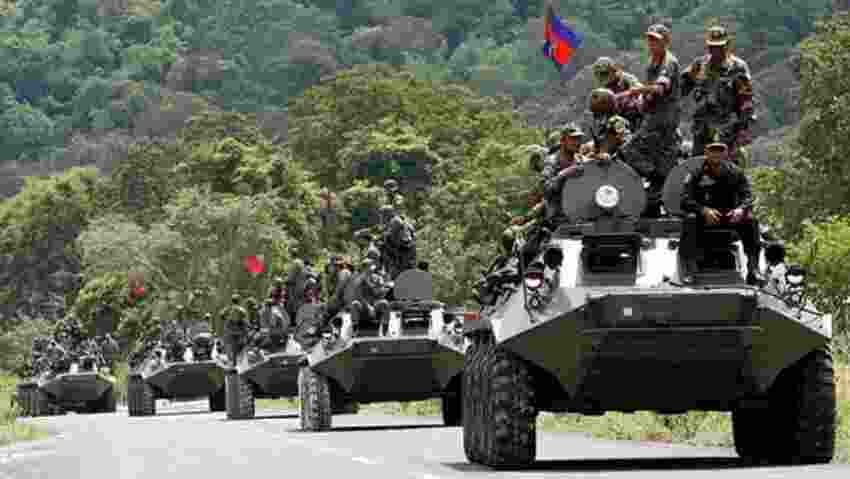Clashes at the Cambodia–Thailand Conflict Border Escalate Fast
Let’s make a deep dive into a Cambodia–Thailand Conflict: The long-standing tension between Cambodia and Thailand has exploded into violence. Fighting broke out near the ancient Prasat Ta Muen Thom temple, leaving thousands of families scrambling for safety.
This is the most severe conflict between the two nations in over a decade. It’s not just about land—politics, pride, and power are all fueling the flames.
Cambodia–Thailand Conflict: More Than 130,000 People Forced to Flee
As gunfire and shelling shook towns near the border, civilians ran for their lives. Thailand’s Health Ministry confirmed 131,000 people have evacuated from nearby provinces.
In Cambodia, many used tractors and carts to flee rural villages. Additionally, entire families left behind everything but the essentials.
“We just took the kids and ran into the forest,” said Sokha, a mother of four.
Shelters are now overcrowded. People are desperate for food, water, and medical care.
Deadly Consequences of the Cambodia–Thailand Conflict
At least 15 people have died in Thailand since fighting started. Cambodia has reported one confirmed death, with more injuries likely.
Gunfire continues across the disputed zone. Explosions have damaged homes, schools, and clinics. Fear spreads quickly as families must to move again and again.
Cambodia–Thailand Conflict: The History Behind the Conflict
Cambodia–Thailand Conflict: A Temple and a Border Without Agreement
The Prasat Ta Muen Thom temple sits on a disputed border area. In 1962, the International Court of Justice ruled that the temple belongs to Cambodia. Thailand disagrees over the land surrounding it.
This area has been a hotspot for years. From 2008 to 2011, both sides clashed regularly. Also, dozens died. Even after a ceasefire, the most important issues are not done.
In fact, the Cambodia-Thailand border has long been a tinderbox of tension, with a history of conflict that cannot be overlooked.
Between 2008 and 2011, repeated clashes resulted in numerous fatalities and deepened animosities, highlighting the fragile nature of peace in this region.
Although a ceasefire was declared, the root causes of this conflict—territorial disputes and nationalistic fervor—remain unaddressed, leading to a dangerous resurgence of violence.
Recommended by Nova News:
Today, tens of thousands are fleeing their homes, underscoring the urgent need for a resolution. It’s essential to grasp the complexities of this situation, as it not only affects those living on the frontlines but also poses significant risks to regional stability and international relations.
Cambodia–Thailand Conflict: Tensions Rise as Diplomacy Fails
In fact, the current violence has strained diplomatic ties. Cambodia expelled Thailand’s ambassador. Thailand responded by doing the same.
On social media, political leaders exchanged harsh words. However, former Thai Prime Minister Thaksin Shinawatra called for strong military action. This is a dangerous provocation says Cambodian leader Hun Sen.
These public statements made the crisis worse. They also made it harder for both countries to de-escalate the situation.
Cambodia–Thailand Conflict: Politics Behind the War
The conflict isn’t just about territory. It’s also about nationalism and political power.
Leaders from both countries have used border disputes to stir up support at home. This tactic distracts from internal problems, but it puts civilians at risk.
The result? A dangerous game where innocent people suffer the most.
Cambodia–Thailand Conflict: Global Leaders Call for Peace
International pressure is building. In addition, the United States call for peace and both countries to stop the fighting immediately. The U.S. also make a call for a return to peaceful talks.
China, a major trading partner of both nations, expressed concern. Beijing pushed for regional peace and offered to help mediate.

ASEAN leaders warned that the conflict could destabilize Southeast Asia. They are urging restraint and diplomacy.
How the Cambodia–Thailand Fighting Affects Civilians
Daily Life Disrupted by War
Civilians are the ones suffering most. Homes are destroyed. Schools are shut down. Clinics are running low on medicine and staff.
Children have been pulled out of classrooms. Parents are struggling to feed their families. Relief organizations are doing what they can, but more support is needed.
“We’re running out of supplies. The children are sick. People are scared,” said one aid worker at a Thai border camp.
Cambodia–Thailand Conflict: How Families Are Coping
With few options, many families are finding creative ways to survive. Some have taken refuge in forests. Others rely on neighbors and relatives for food and shelter.
Tractors, bikes, and carts are being used to evacuate entire households. Local communities are pooling resources to care for the displaced.
Still, aid groups say the crisis is growing fast—and they need more help.
Cambodia–Thailand Conflict: What Needs to Happen Next
1. Solve the Border Dispute end the Cambodia–Thailand Conflict
The real solution begins with recognizing the root cause: a disputed border.
Both Cambodia and Thailand must agree to honest talks. In addition,they need to settle the disagreement over who controls which areas—once and for all.
Also, if they avoid the issue, violence will return again and again.
Recommended by Nova News:
2. Cambodia–Thailand Conflict: Bring in Neutral Mediators
Outside help is essential. ASEAN, the United Nations, or countries like China could help mediate.
Creating joint border patrols or conflict prevention groups could stop future clashes. Trust-building steps must follow any ceasefire.
3. Prioritize Humanitarian Aid
People need help now. Shelter, food, clean water, and medicine are critical.
Governments must allow safe access for aid workers. Donors should increase funding to support relief efforts immediately.
4. Cambodia–Thailand Conflict: Promote Peace, Not Hate
Social media and news outlets must stop spreading hateful rhetoric. Politicians need to lower their tone.
Peace messages must reach people on both sides. Schools and public campaigns should teach respect and cooperation—not fear.
Cambodia–Thailand Conflict: What the Future Holds
What do you think? For more, can the Cambodia conflict could get dangerous if leaders don’t act fast. The region is already fragile. More fighting could spread instability across Southeast Asia.
But it doesn’t have to go that way. However, with strong diplomacy and full support from international partners, peace is still possible.
What You Can Do Right Now to Help End The Cambodia–Thailand Conflict
You don’t need to live in Southeast Asia to help:
✅ Stay informed with reliable sources
✅ Share peace messages, not hate
✅ Support charities helping refugees
✅ Call on world leaders to support mediation
Conclusion about Cambodia–Thailand Conflict: Peace Must Come Before Politics
The Cambodia–Thailand fighting is a tragedy—one that was avoidable. In fact, now, tens of thousands are suffering because of a dispute that should have been resolved long ago.
Additionally, we can’t let this crisis grow. Also, governments must put human lives before political wins. Civilians must be with higher protection. And the world must push for peace, not war.

